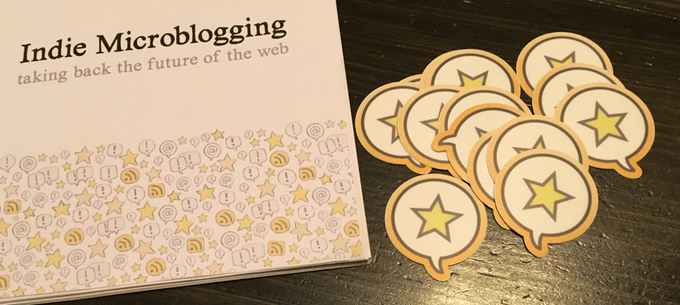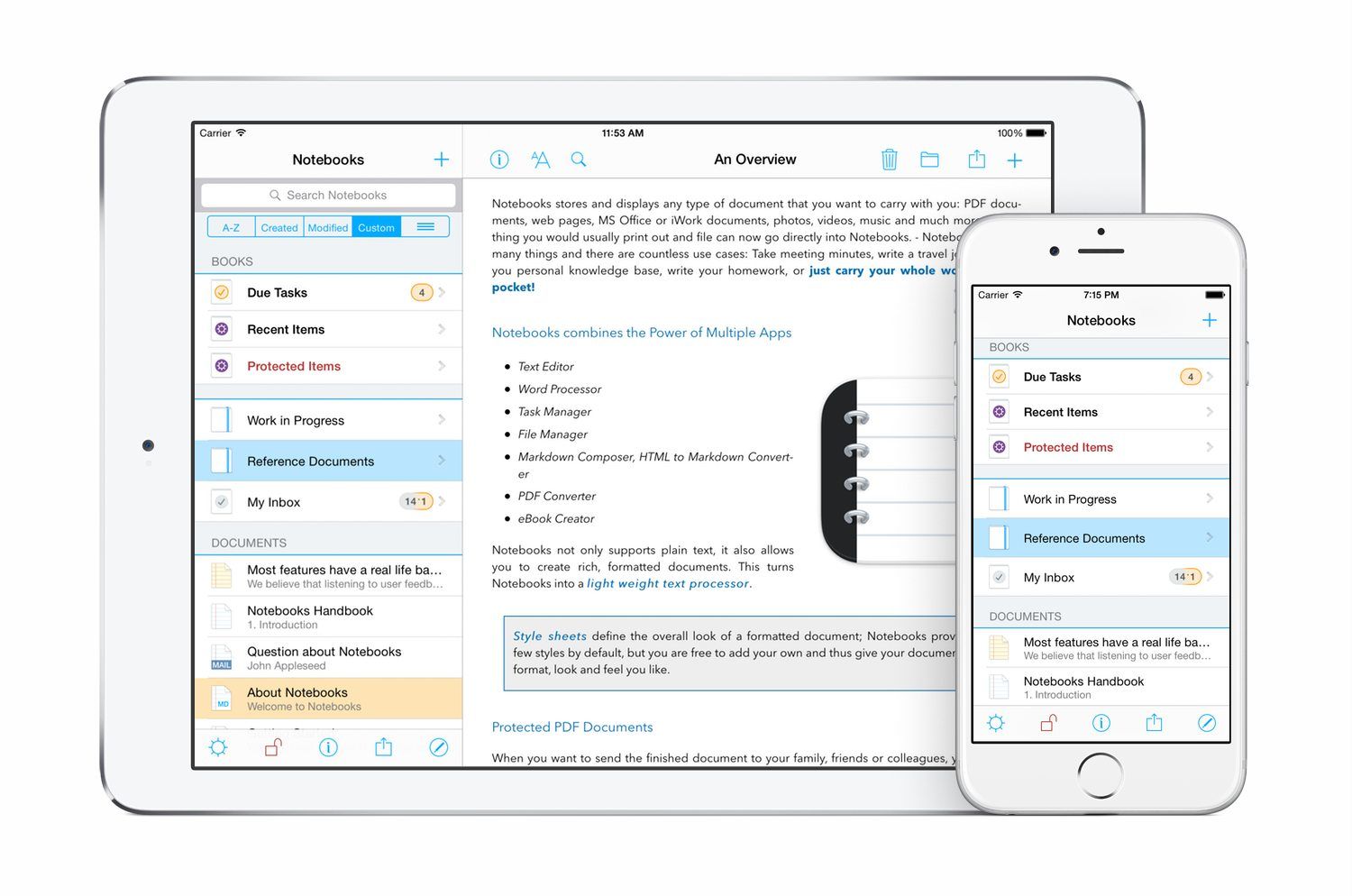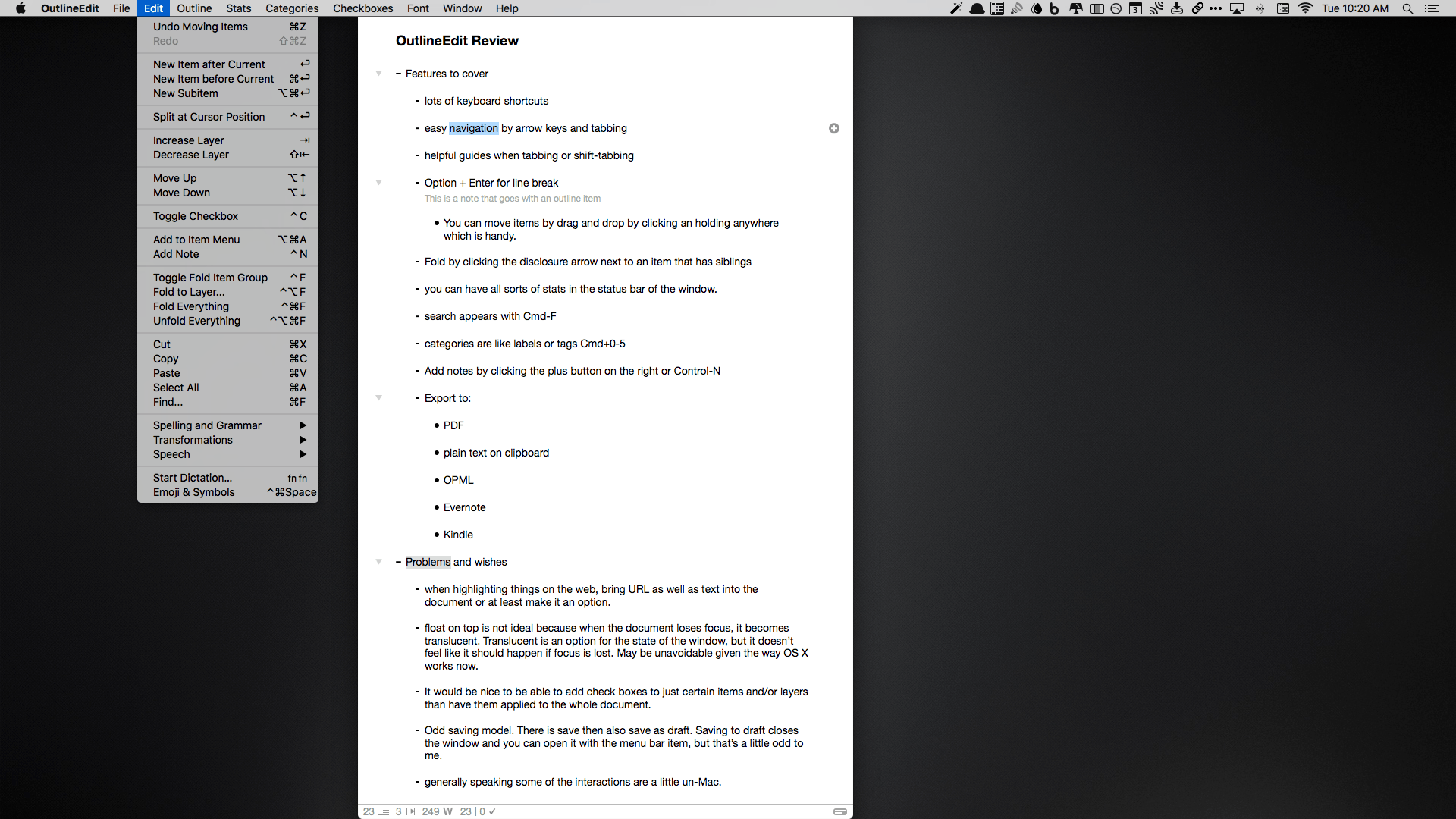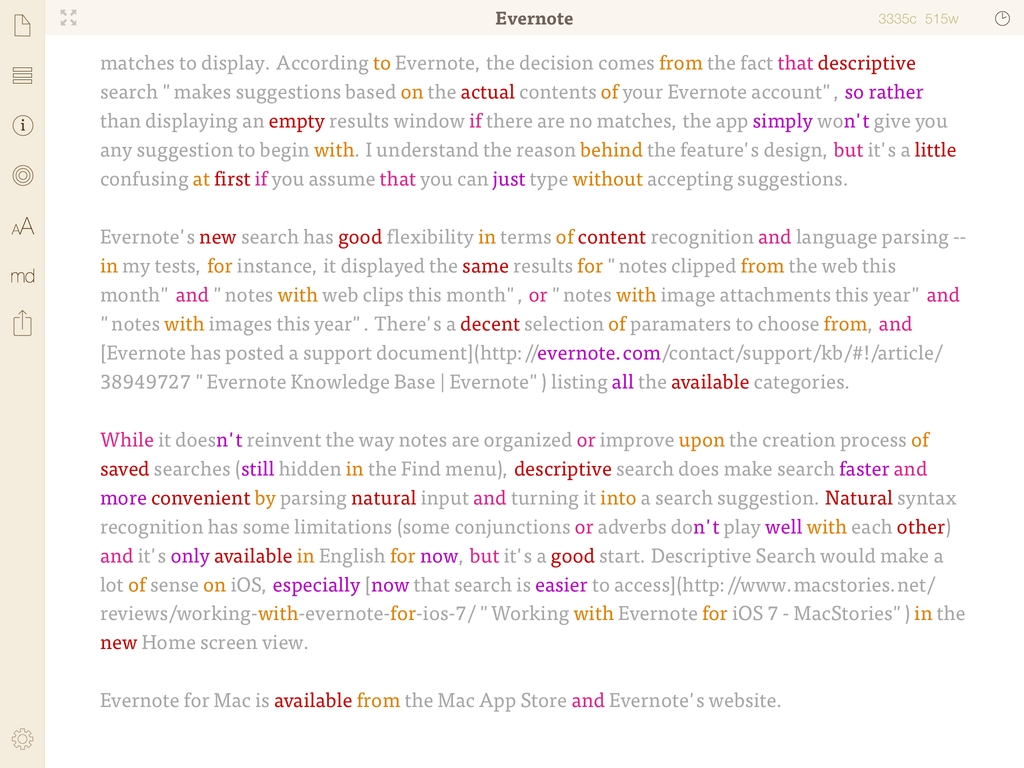Research is an inherently messy, non-linear process. In a traditional note-taking app, text, links, and images quickly wind up a disorganized mess, and moving items around with cut and paste is cumbersome. Milanote is a free-form note-taking web app designed to bring order to the chaos.
Posts tagged with "writing"
Free-Form, Card-based Note Taking with Milanote
Terminology: A Comprehensive Research Tool for Words
I’ve been a fan of Terminology by Agile Tortoise since it debuted in 2010. There are a lot of dictionary apps on the App Store, but most are bloated messes that foist multimedia experiences and games on me when all I want is a definition or synonym. Terminology has alway been just about words. With today’s update, the app has been redesigned from the ground up with new features that make it a must-have research tool for anyone who writes.
Manton Reece Launches Campaign for Microblogging Service and Book→
Today, Manton Reece launched a Kickstarter campaign to raise money for Micro.blog, a platform for independent microblogging and a related book on the subject. Micro.blog has a lot in common with social networks like Twitter, such as replies and favorites, but with an important difference. Instead of locking users into a proprietary system owned by someone else, the content created by individuals is owned and controlled by them. As part of the Micro.blog service, Reece is also building publishing tools with Markdown support, including a native iPhone app, to help people get started with microblogging.
At the core of Micro.blog is an critical design decision – the separation of publishing from social networks. That choice ensures that the microblog content you create remains yours to publish at [your-name].micro.blog or anywhere else you can host a website. At the same time, Micro.blog doesn’t ignore existing social networks. Microblog posts can be cross-posted to other services, which has the potential to give users the best of both worlds – control over their content and access to the broad audiences of services like Twitter.
In addition to Micro.blog, Reece is writing a book on independent microblogging that makes the case for the format and provides practical advice on how to start a microblog. Backers of Reece’s campaign can choose from a variety of rewards that include Reece’s book, early access to the Micro.blog service, free months of the Micro.blog service, and stickers.
New social networks have come and gone over the years, but Reece’s focus on decentralizing microblog publishing from social networks is unique. I had a chance to speak with Manton about Micro.blog at WWDC and know how much time and thought has gone into this project. The campaign is off to a great start and I’m excited to try it soon.
TableFlip Takes the Pain Out of MultiMarkdown Tables
TableFlip, by indie developer Christian Tietze, does something no other Mac app I know of does – it lets you create and edit Markdown tables in a familiar spreadsheet-like interface. Table syntax is part of Fletcher Penny’s MultiMarkdown extension of John Gruber’s Markdown format for displaying HTML in easily readable plain text. MultiMarkdown’s syntax for tables is handy for short tables, but can get unwieldy and complex with larger tables. TableFlip fixes that by letting you flip between a plain text document and a fully-rendered and editable version of your table.
Notebooks for iOS and Mac Organizes Your Research and Reference Materials
There’s a reason why there have been so many different notebook-style apps on iOS and the Mac over the years. Media-rich research projects and reference materials benefit from the familiar metaphor of a notebook as a way to organize everything in one place. The difficulty, though, is balancing organizational functionality with editing tools. Good organizational tools like search, sorting, and sync are a must, but apps that go too deep into editing features can quickly become a bloated mess. Go too light, and the editing features aren’t of much use.
Notebooks by Alfons Schmid is an iOS and Mac notebook app that has excellent organizational tools on iOS and the Mac. With solid search, sorting and sync options, your notebooks and documents are always readily available to you, which makes it a great research tool, especially on iOS. Notebooks’ editing tools are a different story. Notebooks for iOS strikes a nice balance with excellent text and PDF editing tools. The more recently released Mac version of Notebooks, however, doesn’t go much beyond text editing, which is a little disappointing.
Whether Notebooks is right for you will depend on the extent to which you want to edit files stored in it and, if so, whether iOS or OS X is the dominant platform you use. People who work on iOS will love the power of Notebooks; on the Mac, Notebooks is closer to a viewer app and may not be sufficient to meet your needs.
OutlineEdit Packs Power Into a Simple Outliner
I think in outlines. I suppose that’s because it’s what I was trained to do. You see, when I was in law school, we would make elaborate outlines of the subjects we studied to prepare for exams. So over time, I developed a knack for breaking down topics into their component ideas and imposing a hierarchy on them. Nowadays, I still make outlines, but they are usually simple ones that I create while taking notes or brainstorming ideas. I discovered OutlineEdit from Robin Schnaidt recently, and it immediately stuck with me. The speed with which I can get ideas out of my head, into an outline, and then move them around has made it a go-to tool when I’m working on my Mac.
Ulysses (and Other Apps) to Gain Medium Publishing Support→
Ulysses, The Soulmen’s excellent text editor for iOS and OS X, will soon gain a Medium publishing feature thanks to the company’s newly announced API. From their blog post:
You may wonder why we don’t allow you to really publish from Ulysses, as in “publish a story, not just a draft”. For one, Medium’s API has just been released, and we wanted to stay on the safe side. We don’t want you to accidentially publish something you didn’t intend to, or in a state you didn’t mean to make available to the public. Plus, some of Medium’s advanced options, such as pull quotes and fancy header images, are not available yet, so we figured you might love to tinker around a bit, before you really commit your piece.
Lastly… we all make mistakes, and right now there’s no way for us to allow updating your stories from within Ulysses. So again, we figured it would be best to do drafts, since you can have as many drafts as you like, mistakes and all. Plus, this will only get better in the future, so there’s room for anticipation and excitement at your end, too.
In addition, Byword and IA Writer will also receive updates to publish posts to Medium.
I’ve been keeping an eye on Medium, and though it’s not for me, they’ve managed to reignite interest in the idea of a blogging platform – and any respectable blogging platform needs an API. While I won’t move MacStories away from WordPress, it’s good to know that I have another solid option if I should ever decide to use another platform for another website. To me, Medium looks like a cool company that’s trying something new. And I think that’s more important than ever to empower as many potential writers as possible.
On that note, don’t miss Daniel Jalkut’s first look at the Medium API. Daniel has been developing MarsEdit for several years, and he’s the voice I trust when it comes to blogging APIs and native clients.
Efficient Writing On iOS with Phraseology 2.0
My iPad writing setup primarily consists of Evernote, Editorial, and WriteRight, three apps that I use to research, write & edit, and proofread my articles, respectively. For the past few months, I’ve been using Greg Pierce’s Phraseology 2.0 for iPad, which is out today on the App Store and which I consider a must-have companion app for people who write on the iPad and want to craft better text.
Improving The iOS Keyboard→
Improving The iOS Keyboard
Chris Bowler, writing about possible improvements for the iOS keyboard:
The negative with writing on the iPad is typing. It’s a bit of a mixed bag experience — the iOS autocorrection is (at times) brilliant and I can fly along with confidence, knowing the OS is going to correct my typos. But when mistakes are made and are either not autocorrected, or autocorrected incorrectly, then the iPad becomes a less comfortable environment.
Remember when, ahead of the original iPad’s announcement in January 2010, rumors tended to focus on what the “tablet keyboard” would be like? Here are a few examples. In spite of the iPhone having shown that Apple simply wanted a regular keyboard’s appearance translated to multitouch, several people wondered whether Apple should do something different for the bigger screen. The answer was that they simply designed a “full-screen” keyboard.
As Chris notes, over the years third-party developers have extended the iOS keyboard with additional bars. Look at Writing Kit, Pythonista, Textastic, and iA Writer for examples of these modifications.
I think the discussion on the iOS keyboard often mixes writing with editing. Personally, I believe the iOS keyboard is great for writing, because it’s just a normal keyboard, but iOS text selection is in serious need of an update, because it feels outdated. I’m not sure the average user cares about better text selection, but for the sake of the argument, I will say that a better solution should be explored.
If you read those old pre-2010 posts on the “iSlate keyboard”, you’ll notice a common thread: that Apple must build something revolutionary for text entry. I recall some people guessed a split keyboard could be a possible implementation, and, in fact, that one came true in 2011. But what about text selection? I don’t think keeping on adding bars above the keyboard is feasible. Especially on the landscape iPad, a single bar alone sensibly diminishes the space available for writing – space being one of the most commonly cited advantages of the iPad against 16:9 and 16:10 tablets. On the iPhone 5, it’s an acceptable solution thanks to the taller screen, but, then again, the bar is too narrow to be a meaningful improvement.
Rather, I would say entirely new ideas for text selection and manipulation are the future. It’s the reason everyone got excited for the Hooper Selection: once you saw it, it just made perfect sense. Too, I wouldn’t completely forget about features that Apple put on the shelf, as they tend to come back.
So here’s my hope for the future of iOS for writing: the same keyboard, but also new, fresh ideas for text selection and editing.









